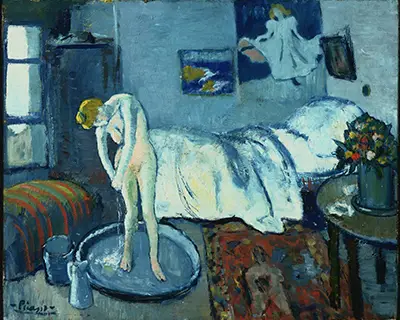The oil on canvas painting was one of his early works and was painted during the artist's Blue Period, most of which is believed to be his best work.
Picasso trained in Madrid and Barcelona, but resided in Paris until 1900, where he was greatly inspired by post impressionist and impressionist painters at the World Exhibition, which he attended. This experience, together with a visit to Paris during 1901, greatly influenced his early works and namely that of his Blue Period, including The Blue Room.
The Blue Room was painted very early on during the Blue Period, that lasted from 1901 through to 1904. The works focussed upon the human form, bathed in different hues of blue. The Blue Room clearly shows a woman, standing naked, in a bedroom having a wash while standing in a tub.
She is bent to the side, looking downwards while water pours away from her body. As an observer we cannot see her face, but Picasso has managed to convey the feeling of harmony and contentment in the use of colour and the way in which the body is relaxed.
The Blue Room is a painting that is fairly sparse in nature. The woman in the painting dominates the scene, with only a bed behind her along one wall, a window to the left of the image and the window seat in front of it. The true beauty in this image comes from the fact that the female form is prominent, due to the use of blue that surrounds the rest of the room.
The eye is also drawn to the right of the picture, where a small round table can be seen, on which is placed a vase of flowers. Then, on the wall behind the bed, we can see three paintings. The one in the middle, which is the largest, clearly shows a young woman in a flowing white dress.
This could be the woman in the painting, or possibly a former model of Picasso's, but the general consensus is that the image is based upon the painting May Milton, by Henri de Toulouse-Lautrec. The Blue Room enthuses cool blue tones, together with natural light, to illuminate the bathing woman. The woman is painted in a form of natural beauty and that of innocence.
Picasso's Blue Period was hugely influenced by the painter, Henri de Toulouse-Lautrec, and his influence can be clearly seen in The Blue Room. The setting for this painting was that of Picasso's study situated along the boulevard de Clichy in Paris. Sadly, Henri de Toulouse-Lautrec did not see the finished painting, as he died shortly before it was finished.
The discovery of a hidden painting, behind that of The Blue Room was found in 2014 by the Philips Collection, based in Washington, via x ray techniques. The canvas of The Blue Room had been used for a prior painting, this was a popular painting method employed by artists of the day, as canvases were expensive to buy and were reused as and when necessary.
The hidden painting is that of an old man who is sat with his head in his hands. There is no information about the mystery man, and historians believe that the painting was painted over, simply because Picasso needed the canvas as opposed to being unsatisfied with the painting.

